Shopify has captured nearly 11 percent of the total eCommerce market share.
It’s become a top choice for those looking to carve out their space in the online marketplace due to the robust tools and resources offered. The ongoing innovation and backing from the platform are expected to connect Shopify sellers with over 700 million potential buyers by 2024.
But success isn’t guaranteed. With competition heating up and consumer behavior changing constantly, standing out is a challenge.
The total annual revenue for all Shopify stores exceeds 5.5 billion, and more than 2.7 million merchants use the platform, making it clear that it is a significant player in online retail.
So, how can you rise above these challenges as a Shopify store owner and truly make your mark? The answer lies in your marketing strategy.
Here are the top six strategies to grow your storefront:
- Optimize your storefront to show up in search engines
- Implement content marketing to drive brand awareness and equity
- Send email campaigns and newsletters with personalized messaging and offers
- Hop on social media platforms for enhanced engagement and sales
- Partner with influencers and content creators to find new audiences
- Collaborate with affiliates to increase return on spend

Optimize your storefront to show up in search engines
You’ve got a fantastic product line and a sleek online storefront. However, even the most attractive and well-stocked Shopify store won’t do much good if your potential customers can’t find it. That’s where SEO, or Search Engine Optimization, comes into play.
So, why is SEO important for your Shopify store? Let’s dive in.
SEO increases store visibility
Google processes more than 3.5 billion searches per day. When you optimize your store for search engines, it’s more likely to appear in the search results when potential customers look for products like yours—which translates to more traffic and, ultimately, more sales.
Using relevant keywords, optimizing metadata, and creating high-quality content can improve your search engine rankings and drive organic traffic to your Shopify store.
SEO targets quality traffic
Unlike traditional “outbound” advertising channels, which involve reaching out to consumers whether they want to hear from you, SEO is an “inbound” strategy. It involves making your store easy to find when people seek information about your product or industry. It’s customer-centric, and it’s effective.
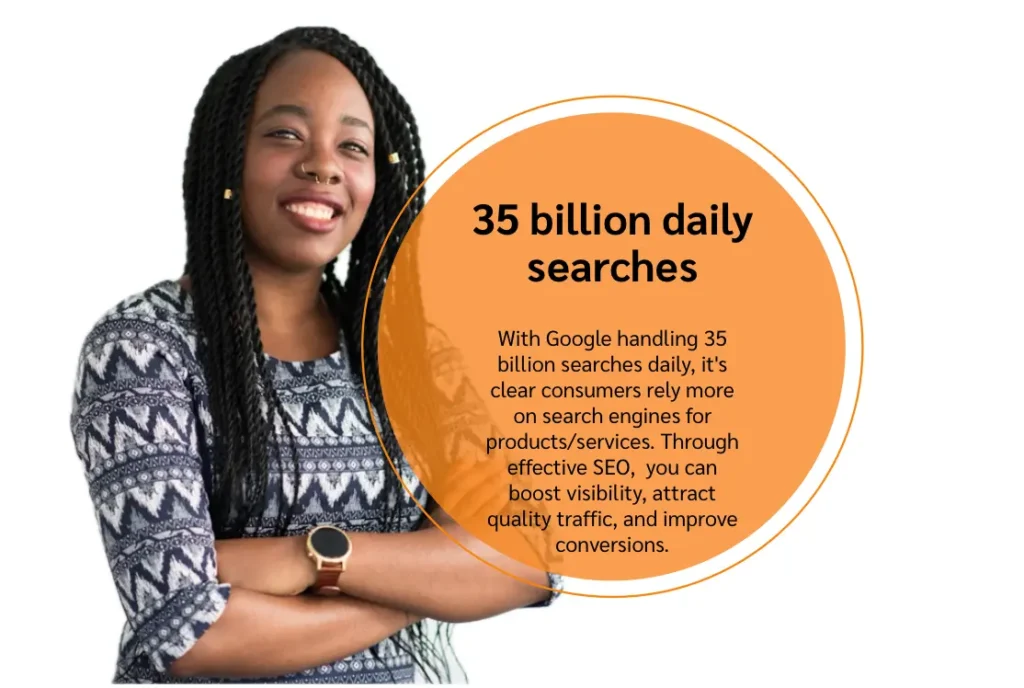
SEO practices enhance the user experience on your site
Search engines like Google prioritize sites that are well-structured, easy to navigate, and filled with relevant content. By optimizing for SEO, you’re also making your site more enjoyable for human visitors. This means better engagement, increased time on site, and more conversions.
Here are some actionable steps you could take:
Optimize your product titles: Make your product titles descriptive and keyword-rich. This tells search engines what your products are about and makes it easier for potential customers to find you.
Leverage meta descriptions: Think of meta descriptions as your storefront’s ad copy on search engine results pages. Write compelling, concise descriptions that include your key phrases to attract clicks.
Use ALT tags: Search engines can’t see images, but can read alt tags. Include descriptive alt tags for all your images, especially product photos.
Implement content marketing to drive brand awareness and equity
Now that you’re searchable, how can you make your brand stand out in the crowded e-commerce space?
The answer is simple: content marketing.
With a well-executed content strategy—including how-to articles, product use videos, case studies, and more—you can build awareness and brand equity that sets you apart from the competition. Let’s explore how.
Content builds awareness
Think of content as your brand’s megaphone. It’s how you tell the world who you are, what you offer, and why it matters. Blog posts, webinars, workshops, and video tutorials offer opportunities to get your message out there and attract potential customers.
And it’s not just about quantity. Quality is crucial. You’ll see more traffic to your store when consistently producing relevant, engaging content.
Content establishes brand equity
In ecommerce, trust is everything. Content helps you establish that trust by showcasing your expertise and credibility. For example, if you run a clothing store, you might share fashion tips or behind-the-scenes looks at how your products are made. This kind of content sells products while telling a story that builds a connection with your audience.
What’s more, informative, relevant content that offers value can turn customers into advocates for your brand.
Here are a few ways to add content to your marketing strategy:
Start a blog to educate people on your industry: It’s your platform to share valuable insights, tips, and updates with your customers. You’re the expert in your field, so why not share that knowledge? And here’s a bonus—search engines love fresh, relevant content.
Create video content to bring people into your business: People spend an average of 17 hours per week watching videos. So, it’s best to catch them with a medium they want to consume. Whether it’s a product demo, a how-to guide, or a peek into your day-to-day operations, video content can be a powerful tool in your marketing arsenal.
Host webinars or workshops: Show off your expertise and interact with your customers in real time. It’s a great way to build trust and establish your brand as an industry leader.
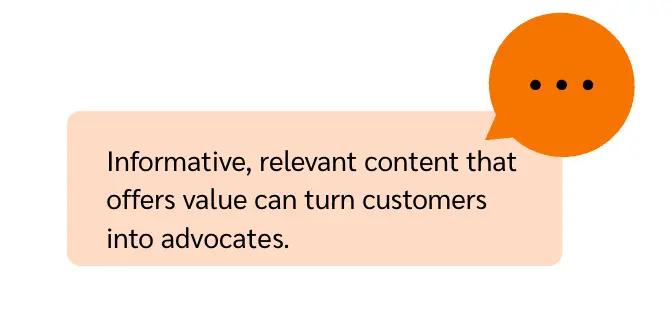
Send email campaigns and newsletters with personalized messaging and offers
Email marketing is direct and personal. It allows you to communicate with your customers on a one-to-one basis. You’re not just a business broadcasting messages into the void but building relationships.
And these relationships can lead to trust, loyalty, and ultimately, sales.
Plus, email marketing is incredibly versatile. From welcome emails and order confirmations to newsletters and special offers—you’ve got a range of options to engage your customers. Each type of email serves a different purpose, yet it all contributes to a cohesive customer journey.
Moreover, with email, you have complete control over your messaging and timing. There’s no algorithm deciding who gets to see your message.
This enables you to deliver relevant information to your customers precisely when it is most needed.
Email is a more cost-effective way to connect
The beauty of email marketing lies in its scalability. Whether you’re reaching out to 100 people or 10,000, the cost remains relatively consistent. This scalability is something you don’t often see with traditional marketing methods, making email an affordable option for businesses of all sizes.
And with scalability, you also get precise targeting.
You can reach the right people at the right time through segmentation and personalization. This reduces wastage and improves conversion rates, giving you more return on effort.
Plus, this channel provides measurable results. Here’s what you can track with Shopify email marketing:
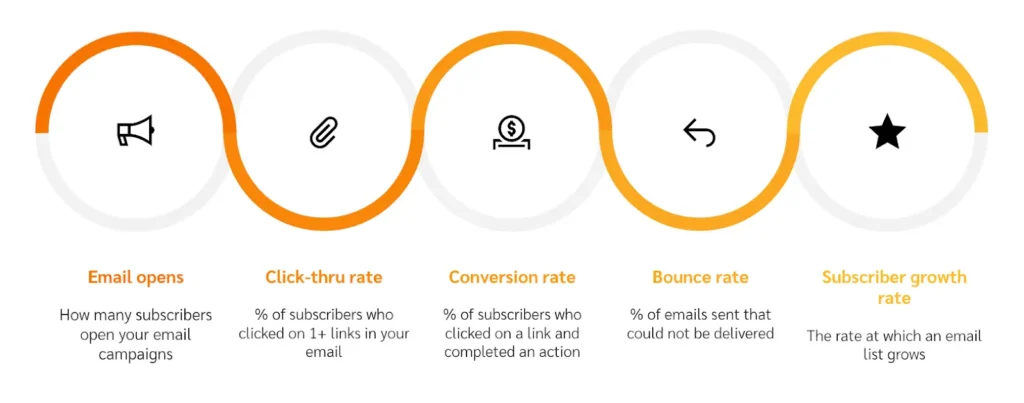
Email opens: This metric tells you how many subscribers opened your email marketing campaigns. Known as the open rate, this is a crucial indicator of how well your subject lines are working to pique the interest of your subscribers.
Click-through rate (CTR): CTR measures the percentage of email recipients who clicked on one or more links contained in an email. This metric helps you understand what content resonates best with your audience.
Conversion rate: This is the percentage of email recipients who clicked on a link within an email and completed a desired action, such as purchasing. Tracking conversions can help you measure the effectiveness of your email marketing campaigns in driving sales.
Bounce rate: This refers to the percentage of your total emails sent that couldn’t be delivered to the recipient’s inbox. A high bounce rate could indicate issues with your subscriber list or delivery issues.
Subscriber growth rate: This measures the rate at which your email list grows. Keeping an eye on this metric can help you gauge the health of your list and the success of your list-building efforts.
This data not only helps you gauge the success of your campaigns but also guides future strategy, ensuring every dollar spent is a dollar well invested.
Get a greater return on your investment with email
On average, businesses see a return on investment (ROI) of $36 for every $1 spent on email marketing. And when it comes to customer acquisition, each send is 40 times more effective at acquiring customers than Meta, making it a powerful tool in your customer acquisition strategy
Hop on social media platforms for enhanced engagement and sales
Connection is paramount, and social media is invaluable for elevating your brand’s presence and driving sales. Engaging on platforms like Instagram, Pinterest, and TikTok can transform how you connect with your audience, offering a blend of entertainment, information, and community building.
Amplify your brand’s voice
Social media offers an unparalleled opportunity to engage with your audience in places they hang out most often. By crafting compelling content that resonates with your followers, you can foster a community of loyal customers eager to support and share your brand.
This includes using stories, live broadcasts, and interactive polls to gauge customer preferences, collect feedback, and personalize the shopping experience.
Share user-generated content to build trust
Statistics reveal that 92 percent of consumers trust user-generated content (UGC) more than traditional advertising. Encouraging your customers to share their experiences with your products provides you with authentic marketing material and builds trust with potential customers browsing your social media channels.
Drive traffic and sales with social commerce features
Platforms like Instagram and TikTok offer integrated shopping features, allowing customers to discover and purchase products without leaving the app. By setting up shop on these platforms, you can streamline the purchasing process, making it as seamless as possible for your customers.
Shopify’s integration with these social commerce features guarantees synchronized inventory and orders, ensuring a streamlined operational process.
Partner with influencers and content creators to find new audiences
Influencer marketing has become a powerful and effective way to reach new audiences and drive sales. By partnering with influencers and content creators in your niche, you can leverage their engaged audience and tap into their credibility to promote your products.
These partners can offer significant advantages for your brands. Here’s how:
Expanded reach: When collaborating with influencers, your brand gains exposure to their established audience. This enables your products to reach thousands or even millions of new customers who may not have otherwise come across your brand.
Trust and authenticity: People tend to trust recommendations from influencers they follow. According to research, nearly 57% say transparency is the most important value they look for when following an influencer. By partnering with these trusted voices, your brand shares that trust, making potential customers more likely to consider your products.
Relevance: Your brand’s best influencers are those with the same audience. This ensures that your products are promoted to people most likely interested in them, increasing the chance of conversions.
Efficiency and revenue: Influencer partnership programs can help your online business become more efficient while bringing in more revenue. Research shows that nearly 2 in 3 brands are increasing their budget for influencer marketing in 2024—which shows the ample opportunity with this channel.
New opportunities: For content creators, platforms such as Shopify Collabs are gateways to new opportunities, enabling them to introduce their followers to brands they genuinely believe in.
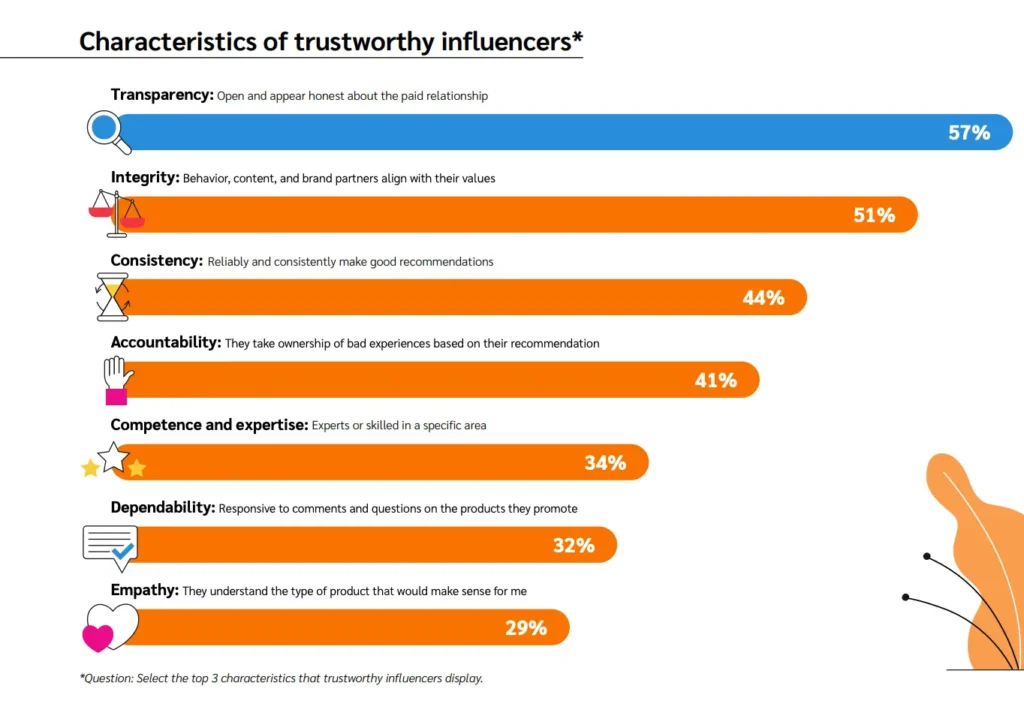
The characteristics of trustworthy influencers as discovered in impact.com’s The state of influencer marketing for consumers in 2023.
Find influencers who align with your brand values
Your influencer partners should sync with your brand and have a following that matches your target audience. This alignment ensures their endorsement will resonate and lead to genuine interest in your products.
Once you’ve identified these influencers, it’s time to reach out. Your partnership could involve product reviews, sponsored posts, or co-created content. Remember, it’s not just about getting your products in front of their audience. You want to it’s create engaging content that tells your brand story.
BBQGuys exceeded their influencer marketing benchmarks and broke into new audience segments
BBQGuys, a leading player in the grilling space, had its sights set on a diverse crowd—urban dwellers, LGBTQ+ couples, and female campers. The brand teamed up with impact.com’s managed services team, a partnership that allowed the team to break into new markets.
Together, they crafted a strategy to commission original content in diverse formats. The team also negotiated usage rights to repurpose it across different channels. This further amplified their reach, making the most of their influencers’ creativity.
The campaign generated over 90k impressions and almost 3k engagements, more than the contracted goal. And the engagement rate? An impressive 5.5 percent, more than double the benchmark for similar programs.
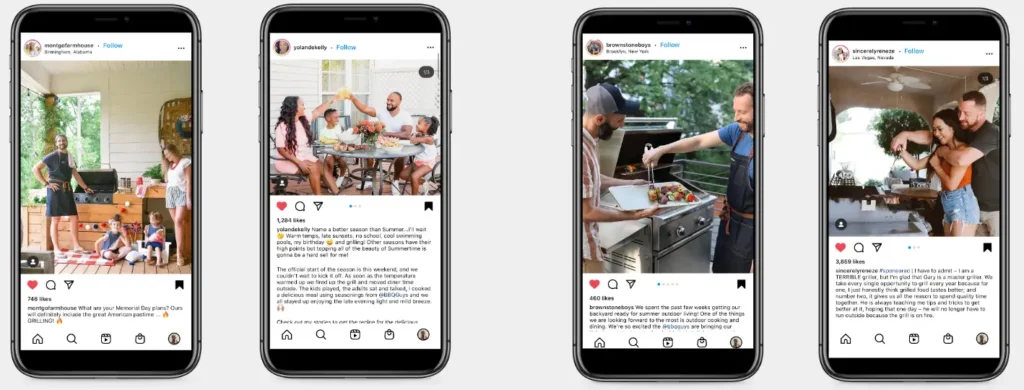
Campaign creatives from influencer partners that helped BBQGuys reach new audience segments.
Collaborate with affiliates to increase return on spend
Unlike traditional advertising—where you pay upfront regardless of the results—affiliate marketing operates a pay-for-performance model. That means you only pay when a specific action, like a sale, lead, or click, is completed.
Imagine this: Instead of spending large amounts on ads and hoping for the best, you invest in partnerships with affiliates who promote your products to their audience. When their followers purchase through their unique link, you pay them a commission.
The result? More sales for you at a fraction of the cost of traditional advertising.
According to a study by the Performance Marketing Association, businesses earn an average of $6.85 for every dollar spent on affiliate marketing. This makes it a highly effective and cost-efficient way to drive sales for your Shopify store.
Cozy Earth built relationships with new partners and optimized existing relationships to obtain 109 percent YoY growth
Cozy Earth specializes in ethically produced luxury bedding, sleepwear, and loungewear. Not too long ago, they faced challenges with a limited pool of content partners and a lack of visibility in reporting.
The team migrated 60 partners onto the impact.com platform, building relationships with new content partners, optimizing existing partner relationships, blending PR and affiliate marketing strategies, and achieving a whopping 60 percent YoY business growth.
With newly implemented tracking and reporting capabilities, they could see exactly how each partner performed. This meant they could communicate regularly with partners, tweak their strategy, and make data-driven decisions.
And what was the outcome?
Cozy Earth experienced a staggering 109 percent YoY program growth in 2022, with a 72 percent YoY spending increase. They achieved a 912:1 return on investment in partnerships and saw a 92 percent YoY increase in online store traffic, with content partnerships accounting for 55 percent of their revenue.
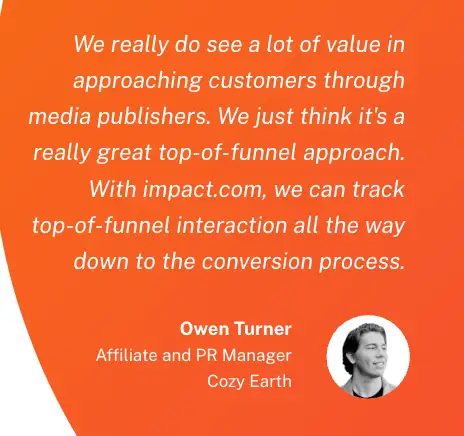
Prepare your partners with the right resources
To achieve great success, it’s key to equip your affiliates and influencers with marketing materials, tracking tools, and incentives to boost their efforts and generate more revenue for your Shopify store.
Platforms like impact.com provide a space to find new partners, collaborate, share assets, and handle tracking and reporting seamlessly within the software. Plus, they handle the payments, too!
Essential tools and strategies to drive your growth on Shopify
A comprehensive marketing strategy is vital for the success of your Shopify store. SEO, social media, influencer, and content marketing, along with strategic affiliate partnerships managed on platforms like impact.com, are not just strategies but essential tools that can drive your Shopify store’s growth.
Like Cozy Earth, your store can use these strategies to exceed your growth expectations, proving that the potential for success is limitless with the right tools and approaches.
FAQ
Understanding your customers and tailoring your offerings to their needs is key to growth. Enhancing your online presence with a user-friendly website and SEO optimization can boost visibility.
At the same time, leveraging tools like email marketing and social media can deepen customer engagement. And, don’t forget, a loyalty program can turn one-time shoppers into repeat customers, solidifying your store’s success.
Start by identifying the social platforms where your target customers hang out, and create engaging, shareable content tailored to those audiences. Use paid ads on these platforms to reach a wider audience and consider collaborating with influencers who resonate with your brand.
Then, engage with your followers regularly—respond to comments, host giveaways, and show appreciation. It’s all about building a community around your brand.
With impact.com, you can effortlessly integrate your Shopify store for a streamlined affiliate marketing strategy. First, connect your store to Impact.com’s platform to access a network of potential partners and relevant influencers. Then, use their robust tracking and analytics tools to monitor your campaign’s performance and optimize it accordingly, making your Shopify store thrive like never before.
To target your audience on Shopify, first understand who they are by analyzing your store’s data and customer behavior. You’ll also want to create personalized marketing campaigns, such as email marketing or retargeting ads, to reach these specific groups. And finally, improve your product offerings and store design based on your audience’s preferences and feedback to enhance their shopping experience.





